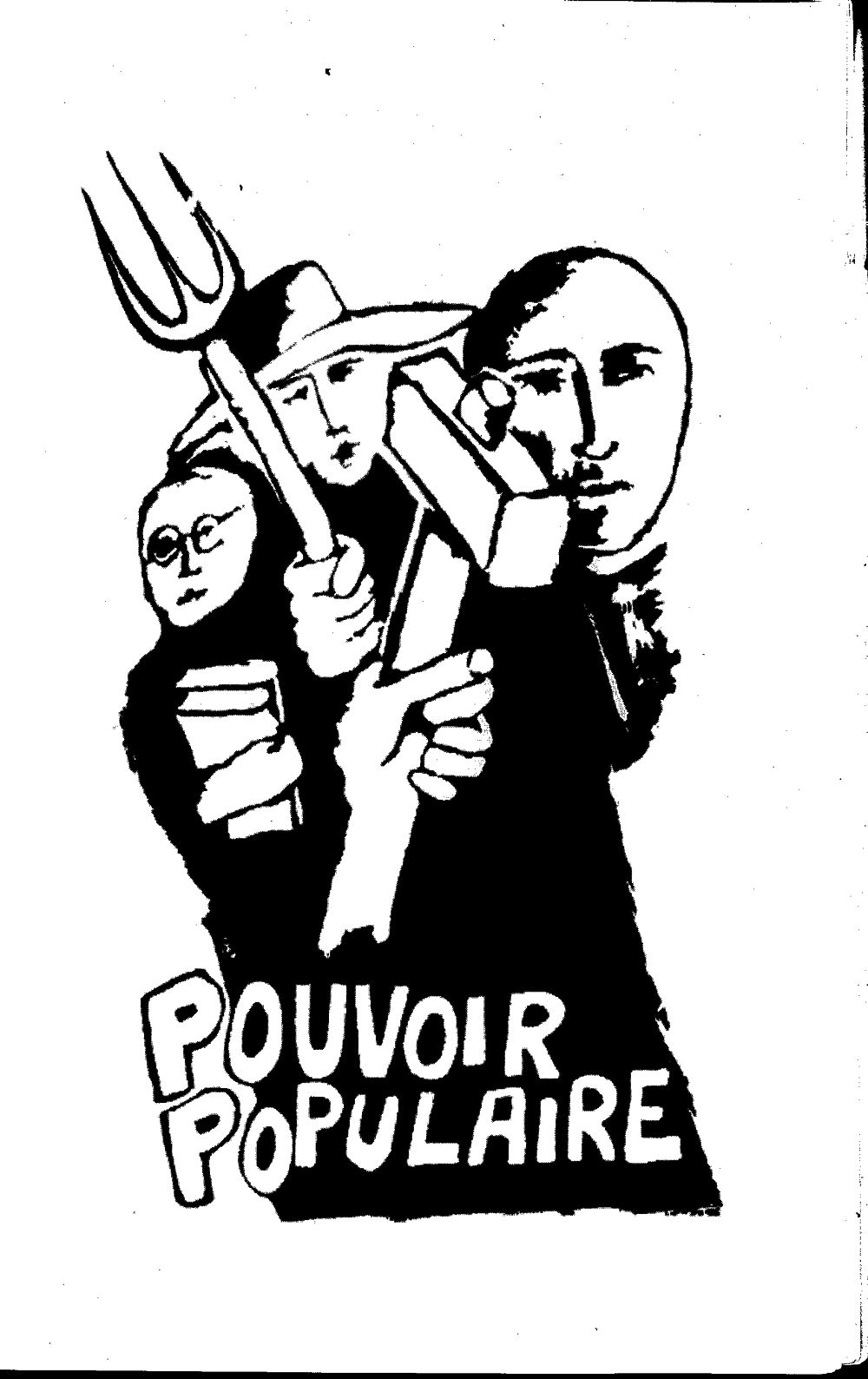When Poetry Ruled the Streets: The University as a Red Base (pages 12-13 of Cahiers de mai no.1); Nantes (pages 4-7 of Cahiers de mai no.1); From Roadblocks to Self-Defense (pages 8-11 of Cahiers de mai no.1)
Thumbnail
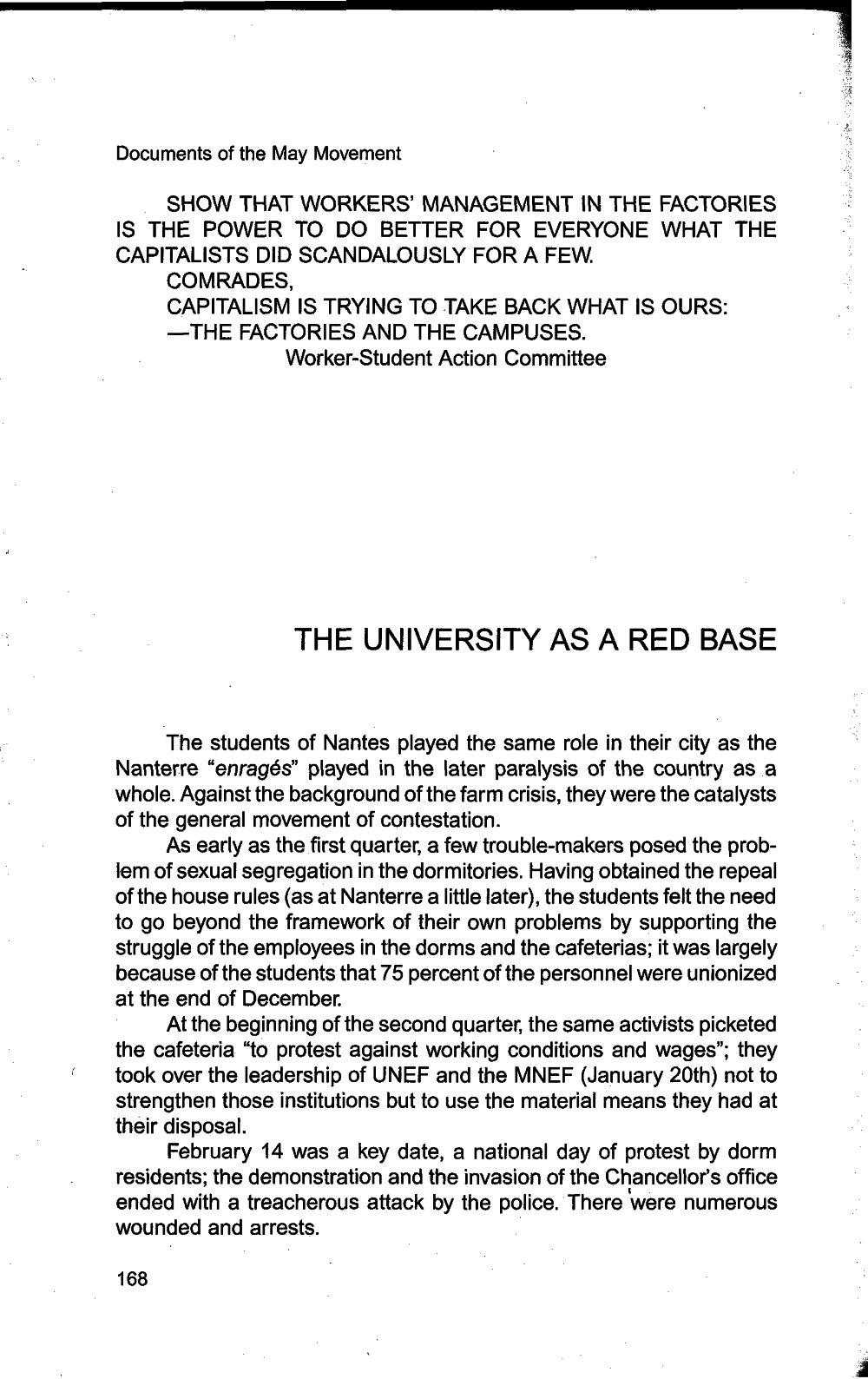

Documents of the May Movement
SHOW THAT WORKERS' MANAGEMENT IN THE FACTORIES
IS THE POWER TO DO BETTER FOR EVERYONE WHAT THE
CAPITALISTS DID SCANDALOUSLY FOR A FEW.
IS THE POWER TO DO BETTER FOR EVERYONE WHAT THE
CAPITALISTS DID SCANDALOUSLY FOR A FEW.
COMRADES,
CAPITALISM IS TRYING TO TAKE BACK WHAT IS OURS:
—THE FACTORIES AND THE CAMPUSES.
Worker-Student Action Committee
Worker-Student Action Committee
THE UNIVERSITY AS A RED BASE
The students of Nantes played the same role in their city as the
Nanterre "enrages" played in the later paralysis of the country as a
whole. Against the background of the farm crisis, they were the catalysts
of the general movement of contestation.
Nanterre "enrages" played in the later paralysis of the country as a
whole. Against the background of the farm crisis, they were the catalysts
of the general movement of contestation.
As early as the first quarter, a few trouble-makers posed the prob-
lem of sexual segregation in the dormitories. Having obtained the repeal
of the house rules (as at Nanterre a little later), the students felt the need
to go beyond the framework of their own problems by supporting the
struggle of the employees in the dorms and the cafeterias; it was largely
because of the students that 75 percent of the personnel were unionized
at the end of December.
lem of sexual segregation in the dormitories. Having obtained the repeal
of the house rules (as at Nanterre a little later), the students felt the need
to go beyond the framework of their own problems by supporting the
struggle of the employees in the dorms and the cafeterias; it was largely
because of the students that 75 percent of the personnel were unionized
at the end of December.
At the beginning of the second quarter, the same activists picketed
the cafeteria "to protest against working conditions and wages"; they
took over the leadership of UNEF and the MNEF (January 20th) not to
strengthen those institutions but to use the material means they had at
their disposal.
the cafeteria "to protest against working conditions and wages"; they
took over the leadership of UNEF and the MNEF (January 20th) not to
strengthen those institutions but to use the material means they had at
their disposal.
February 14 was a key date, a national day of protest by dorm
residents; the demonstration and the invasion of the Chancellor's office
ended with a treacherous attack by the police. There were numerous
wounded and arrests.
residents; the demonstration and the invasion of the Chancellor's office
ended with a treacherous attack by the police. There were numerous
wounded and arrests.
168
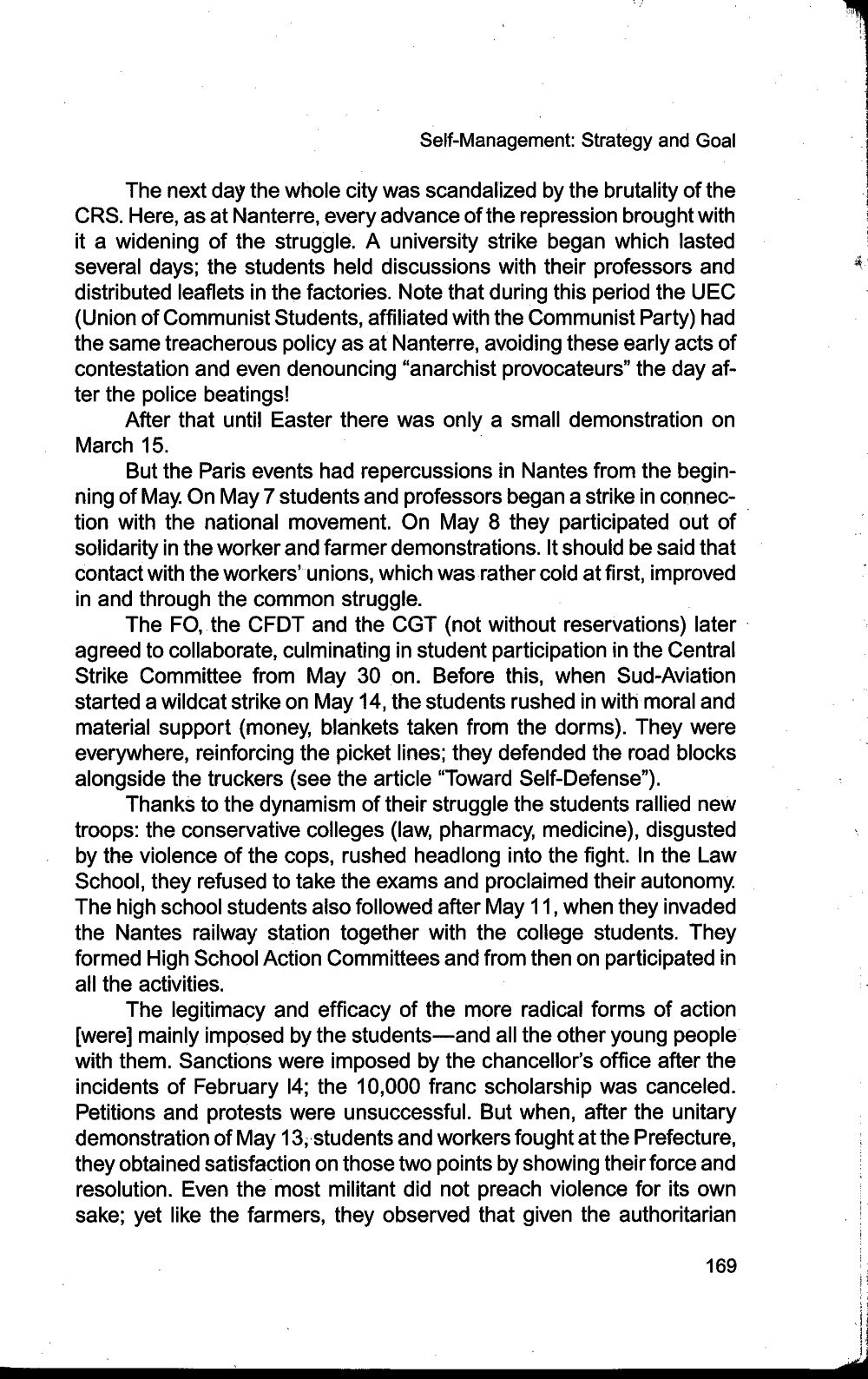

Self-Management: Strategy and Goal
The next day the whole city was scandalized by the brutality of the
CRS. Here, as at Nanterre, every advance of the repression brought with
it a widening of the struggle. A university strike began which lasted
several days; the students held discussions with their professors and
distributed leaflets in the factories. Note that during this period the UEC
(Union of Communist Students, affiliated with the Communist Party) had
the same treacherous policy as at Nanterre, avoiding these early acts of
contestation and even denouncing "anarchist provocateurs" the day af-
ter the police beatings!
CRS. Here, as at Nanterre, every advance of the repression brought with
it a widening of the struggle. A university strike began which lasted
several days; the students held discussions with their professors and
distributed leaflets in the factories. Note that during this period the UEC
(Union of Communist Students, affiliated with the Communist Party) had
the same treacherous policy as at Nanterre, avoiding these early acts of
contestation and even denouncing "anarchist provocateurs" the day af-
ter the police beatings!
After that until Easter there was only a small demonstration on
March 15.
March 15.
But the Paris events had repercussions in Nantes from the begin-
ning of May. On May 7 students and professors began a strike in connec-
tion with the national movement. On May 8 they participated out of
solidarity in the worker and farmer demonstrations. It should be said that
contact with the workers' unions, which was rather cold at first, improved
in and through the common struggle.
ning of May. On May 7 students and professors began a strike in connec-
tion with the national movement. On May 8 they participated out of
solidarity in the worker and farmer demonstrations. It should be said that
contact with the workers' unions, which was rather cold at first, improved
in and through the common struggle.
The FO, the CFDT and the CGT (not without reservations) later
agreed to collaborate, culminating in student participation in the Central
Strike Committee from May 30 on. Before this, when Sud-Aviation
started a wildcat strike on May 14, the students rushed in with moral and
material support (money, blankets taken from the dorms). They were
everywhere, reinforcing the picket lines; they defended the road blocks
alongside the truckers (see the article "Toward Self-Defense").
agreed to collaborate, culminating in student participation in the Central
Strike Committee from May 30 on. Before this, when Sud-Aviation
started a wildcat strike on May 14, the students rushed in with moral and
material support (money, blankets taken from the dorms). They were
everywhere, reinforcing the picket lines; they defended the road blocks
alongside the truckers (see the article "Toward Self-Defense").
Thanks to the dynamism of their struggle the students rallied new
troops: the conservative colleges (law, pharmacy, medicine), disgusted
by the violence of the cops, rushed headlong into the fight. In the Law
School, they refused to take the exams and proclaimed their autonomy.
The high school students also followed after May 11, when they invaded
the Nantes railway station together with the college students. They
formed High School Action Committees and from then on participated in
all the activities.
troops: the conservative colleges (law, pharmacy, medicine), disgusted
by the violence of the cops, rushed headlong into the fight. In the Law
School, they refused to take the exams and proclaimed their autonomy.
The high school students also followed after May 11, when they invaded
the Nantes railway station together with the college students. They
formed High School Action Committees and from then on participated in
all the activities.
The legitimacy and efficacy of the more radical forms of action
[were] mainly imposed by the students—and all the other young people
with them. Sanctions were imposed by the chancellor's office after the
incidents of February 14; the 10,000 franc scholarship was canceled.
Petitions and protests were unsuccessful. But when, after the unitary
demonstration of May 13, students and workers fought at the Prefecture,
they obtained satisfaction on those two points by showing their force and
resolution. Even the most militant did not preach violence for its own
sake; yet like the farmers, they observed that given the authoritarian
[were] mainly imposed by the students—and all the other young people
with them. Sanctions were imposed by the chancellor's office after the
incidents of February 14; the 10,000 franc scholarship was canceled.
Petitions and protests were unsuccessful. But when, after the unitary
demonstration of May 13, students and workers fought at the Prefecture,
they obtained satisfaction on those two points by showing their force and
resolution. Even the most militant did not preach violence for its own
sake; yet like the farmers, they observed that given the authoritarian
169
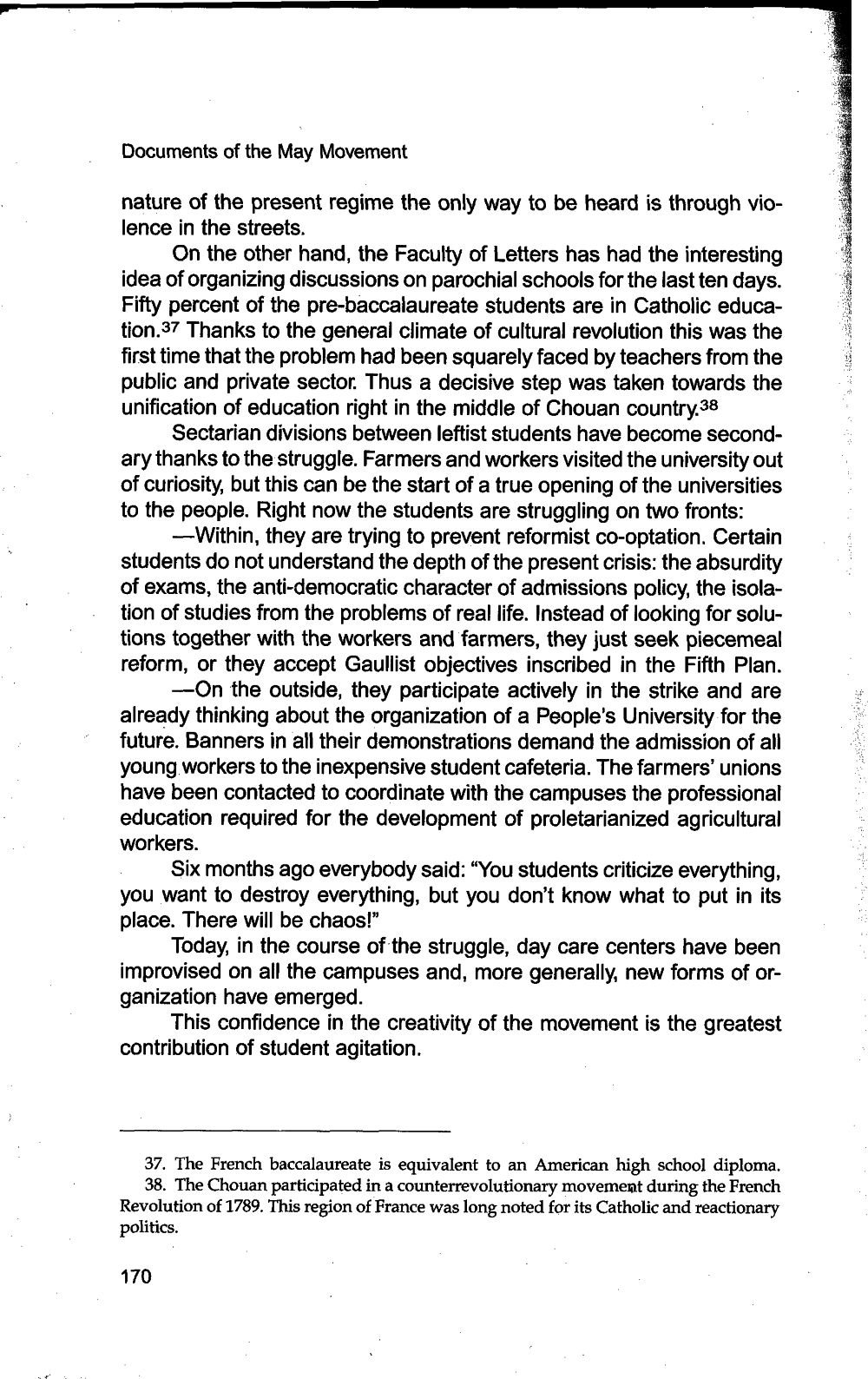

Documents of the May Movement
nature of the present regime the only way to be heard is through vio-
lence in the streets.
lence in the streets.
On the other hand, the Faculty of Letters has had the interesting
idea of organizing discussions on parochial schools for the last ten days.
Fifty percent of the pre-baccalaureate students are in Catholic educa-
tion.37 Thanks to the general climate of cultural revolution this was the
first time that the problem had been squarely faced by teachers from the
public and private sector. Thus a decisive step was taken towards the
unification of education right in the middle of Chouan country.38
idea of organizing discussions on parochial schools for the last ten days.
Fifty percent of the pre-baccalaureate students are in Catholic educa-
tion.37 Thanks to the general climate of cultural revolution this was the
first time that the problem had been squarely faced by teachers from the
public and private sector. Thus a decisive step was taken towards the
unification of education right in the middle of Chouan country.38
Sectarian divisions between leftist students have become second-
ary thanks to the struggle. Farmers and workers visited the university out
of curiosity, but this can be the start of a true opening of the universities
to the people. Right now the students are struggling on two fronts:
ary thanks to the struggle. Farmers and workers visited the university out
of curiosity, but this can be the start of a true opening of the universities
to the people. Right now the students are struggling on two fronts:
—Within, they are trying to prevent reformist co-optation. Certain
students do not understand the depth of the present crisis: the absurdity
of exams, the anti-democratic character of admissions policy, the isola-
tion of studies from the problems of real life. Instead of looking for solu-
tions together with the workers and farmers, they just seek piecemeal
reform, or they accept Gaullist objectives inscribed in the Fifth Plan.
students do not understand the depth of the present crisis: the absurdity
of exams, the anti-democratic character of admissions policy, the isola-
tion of studies from the problems of real life. Instead of looking for solu-
tions together with the workers and farmers, they just seek piecemeal
reform, or they accept Gaullist objectives inscribed in the Fifth Plan.
—On the outside, they participate actively in the strike and are
already thinking about the organization of a People's University for the
future. Banners in all their demonstrations demand the admission of all
young workers to the inexpensive student cafeteria. The farmers' unions
have been contacted to coordinate with the campuses the professional
education required for the development of proletarianized agricultural
workers.
already thinking about the organization of a People's University for the
future. Banners in all their demonstrations demand the admission of all
young workers to the inexpensive student cafeteria. The farmers' unions
have been contacted to coordinate with the campuses the professional
education required for the development of proletarianized agricultural
workers.
Six months ago everybody said: "You students criticize everything,
you want to destroy everything, but you don't know what to put in its
place. There will be chaos!"
you want to destroy everything, but you don't know what to put in its
place. There will be chaos!"
Today, in the course of the struggle, day care centers have been
improvised on all the campuses and, more generally, new forms of or-
ganization have emerged.
improvised on all the campuses and, more generally, new forms of or-
ganization have emerged.
This confidence in the creativity of the movement is the greatest
contribution of student agitation.
contribution of student agitation.
37. The French baccalaureate is equivalent to an American high school diploma.
38. The Chouan participated in a counterrevolutionary movement during the French
Revolution of 1789. This region of France was long noted for its Catholic and reactionary
politics.
Revolution of 1789. This region of France was long noted for its Catholic and reactionary
politics.
170

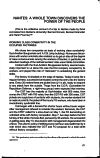
NANTES: A WHOLE TOWN DISCOVERS THE
POWER OF THE PEOPLE
(This is the collective account of a trip to Nantes made by three
comrades from Nanterre University: Bernard Conein, Bernard Granotier
and Henri Fournie.)39
comrades from Nanterre University: Bernard Conein, Bernard Granotier
and Henri Fournie.)39
WORKING CLASS COMBATIVITY IN THE
OCCUPIED FACTORIES
OCCUPIED FACTORIES
We chose two companies as tests of working class combativity:
Sud-Aviation Bouguenais and A.C.B. (ship building). Numerous discus-
sions with worker unionists also enabled us to get an idea of the degree
of class consciousness among the workers of Nantes; in particular, we
attended meetings of the railroad workers' inter-union Strike Committee.
Sud-Aviation Bouguenais and A.C.B. (ship building). Numerous discus-
sions with worker unionists also enabled us to get an idea of the degree
of class consciousness among the workers of Nantes; in particular, we
attended meetings of the railroad workers' inter-union Strike Committee.
Contact with the Sud-Aviation Bouguenais factory seemed espe-
cially important to us since this was the first company occupied by its
workers, and played the role of "detonator" in unleashing the general
strike.
cially important to us since this was the first company occupied by its
workers, and played the role of "detonator" in unleashing the general
strike.
The factory is situated on the edge of Nantes. Today it looks like a
regular fortress; successive barricades control the entry into the factory
area. Every 20 meters there are picket lines (21 in all), ready to respond
to any attack from the outside. Thugs from the C.D.R. (Committee for
Republican Defense, a right-wing group) were expected that evening.
regular fortress; successive barricades control the entry into the factory
area. Every 20 meters there are picket lines (21 in all), ready to respond
to any attack from the outside. Thugs from the C.D.R. (Committee for
Republican Defense, a right-wing group) were expected that evening.
The CGT has the majority at Sud-Aviation with 800 votes, then
comes the CFDT with 700 votes, then the CGT-FO with 300 votes. CGT
pickets are suspicious of contacts with students; the worker-student link
is made at point 16, the picket of the hourly FO workers, who have taken a
revolutionary syndicalist line.
comes the CFDT with 700 votes, then the CGT-FO with 300 votes. CGT
pickets are suspicious of contacts with students; the worker-student link
is made at point 16, the picket of the hourly FO workers, who have taken a
revolutionary syndicalist line.
It all began with a demand for shorter hours without lower wages.
After management refused to consider the workers' demands, the CGT
and the CFDT called for a slow-down on May 1, the FO demanding an
unlimited strike with factory occupation. May 7, two days before the first
full day of the strike, the boss fled, pursued by 35 workers. He succeeded
in getting away. May 10, discussions with management degenerated into
a farce. The unions' policy of striking every half hour was reaffirmed by a
vote which also rejected the CGT and FO proposal for a total strike
without factory occupation.
After management refused to consider the workers' demands, the CGT
and the CFDT called for a slow-down on May 1, the FO demanding an
unlimited strike with factory occupation. May 7, two days before the first
full day of the strike, the boss fled, pursued by 35 workers. He succeeded
in getting away. May 10, discussions with management degenerated into
a farce. The unions' policy of striking every half hour was reaffirmed by a
vote which also rejected the CGT and FO proposal for a total strike
without factory occupation.
39. This preferatory note was written by the editors of the journal in which this article
appeared.
appeared.
171
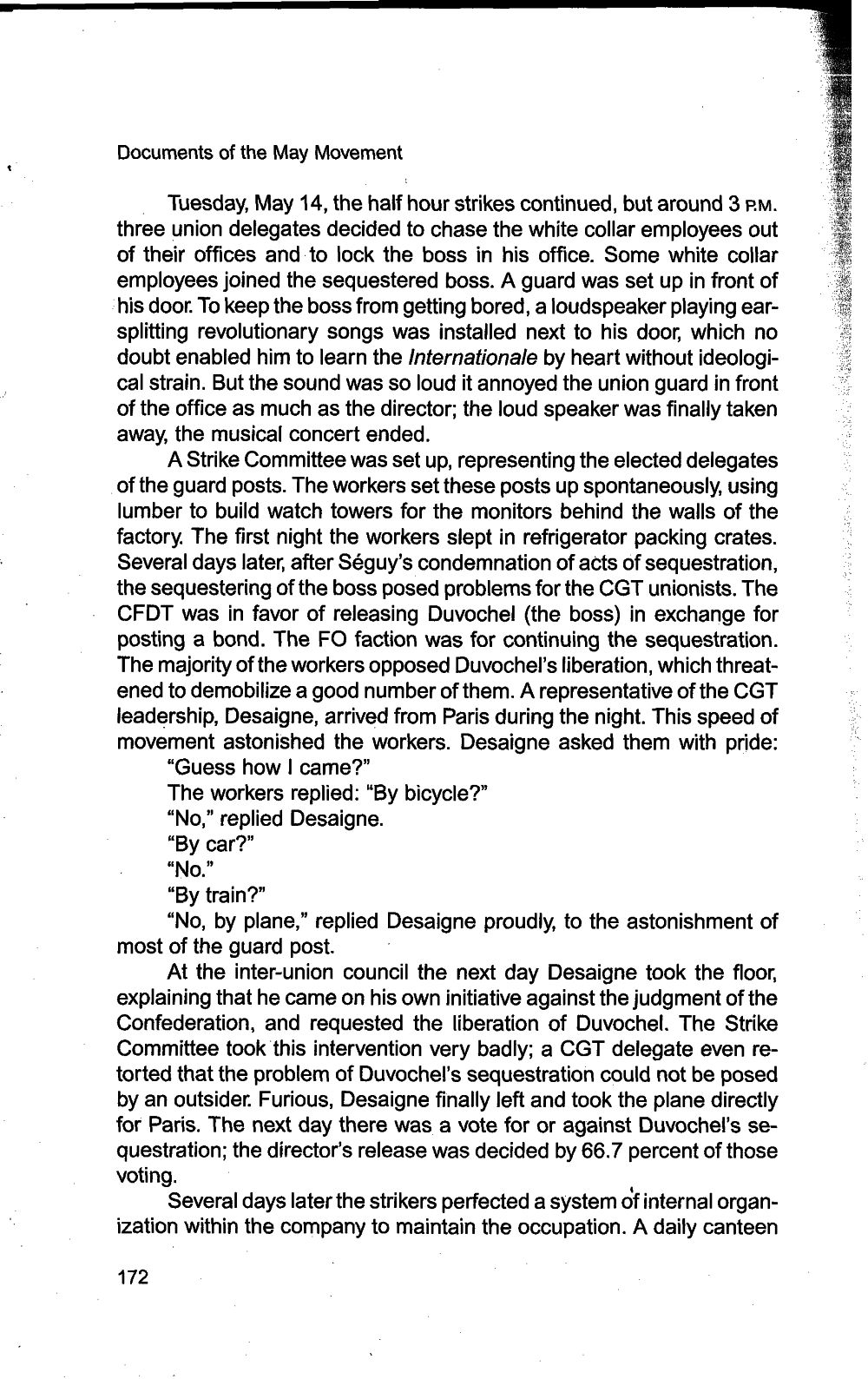

Documents of the May Movement
Tuesday, May 14, the half hour strikes continued, but around 3 P.M.
three union delegates decided to chase the white collar employees out
of their offices and to lock the boss in his office. Some white collar
employees joined the sequestered boss. A guard was set up in front of
his door. To keep the boss from getting bored, a loudspeaker playing ear-
splitting revolutionary songs was installed next to his door, which no
doubt enabled him to learn the Internationale by heart without ideologi-
cal strain. But the sound was so loud it annoyed the union guard in front
of the office as much as the director; the loud speaker was finally taken
away, the musical concert ended.
three union delegates decided to chase the white collar employees out
of their offices and to lock the boss in his office. Some white collar
employees joined the sequestered boss. A guard was set up in front of
his door. To keep the boss from getting bored, a loudspeaker playing ear-
splitting revolutionary songs was installed next to his door, which no
doubt enabled him to learn the Internationale by heart without ideologi-
cal strain. But the sound was so loud it annoyed the union guard in front
of the office as much as the director; the loud speaker was finally taken
away, the musical concert ended.
A Strike Committee was set up, representing the elected delegates
of the guard posts. The workers set these posts up spontaneously, using
lumber to build watch towers for the monitors behind the walls of the
factory. The first night the workers slept in refrigerator packing crates.
Several days later, after Seguy's condemnation of acts of sequestration,
the sequestering of the boss posed problems for the CGT unionists. The
CFDT was in favor of releasing Duvochel (the boss) in exchange for
posting a bond. The FO faction was for continuing the sequestration.
The majority of the workers opposed Duvochel's liberation, which threat-
ened to demobilize a good number of them. A representative of the CGT
leadership, Desaigne, arrived from Paris during the night. This speed of
movement astonished the workers. Desaigne asked them with pride:
of the guard posts. The workers set these posts up spontaneously, using
lumber to build watch towers for the monitors behind the walls of the
factory. The first night the workers slept in refrigerator packing crates.
Several days later, after Seguy's condemnation of acts of sequestration,
the sequestering of the boss posed problems for the CGT unionists. The
CFDT was in favor of releasing Duvochel (the boss) in exchange for
posting a bond. The FO faction was for continuing the sequestration.
The majority of the workers opposed Duvochel's liberation, which threat-
ened to demobilize a good number of them. A representative of the CGT
leadership, Desaigne, arrived from Paris during the night. This speed of
movement astonished the workers. Desaigne asked them with pride:
"Guess how I came?"
The workers replied: "By bicycle?"
"No," replied Desaigne.
"By car?"
"No."
"By train?"
"No, by plane," replied Desaigne proudly, to the astonishment of
most of the guard post.
most of the guard post.
At the inter-union council the next day Desaigne took the floor,
explaining that he came on his own initiative against the judgment of the
Confederation, and requested the liberation of Duvochel. The Strike
Committee took this intervention very badly; a CGT delegate even re-
torted that the problem of Duvochel's sequestration could not be posed
by an outsider. Furious, Desaigne finally left and took the plane directly
for Paris. The next day there was a vote for or against Duvochel's se-
questration; the director's release was decided by 66.7 percent of those
voting.
explaining that he came on his own initiative against the judgment of the
Confederation, and requested the liberation of Duvochel. The Strike
Committee took this intervention very badly; a CGT delegate even re-
torted that the problem of Duvochel's sequestration could not be posed
by an outsider. Furious, Desaigne finally left and took the plane directly
for Paris. The next day there was a vote for or against Duvochel's se-
questration; the director's release was decided by 66.7 percent of those
voting.
Several days later the strikers perfected a system of internal organ-
ization within the company to maintain the occupation. A daily canteen
ization within the company to maintain the occupation. A daily canteen
172
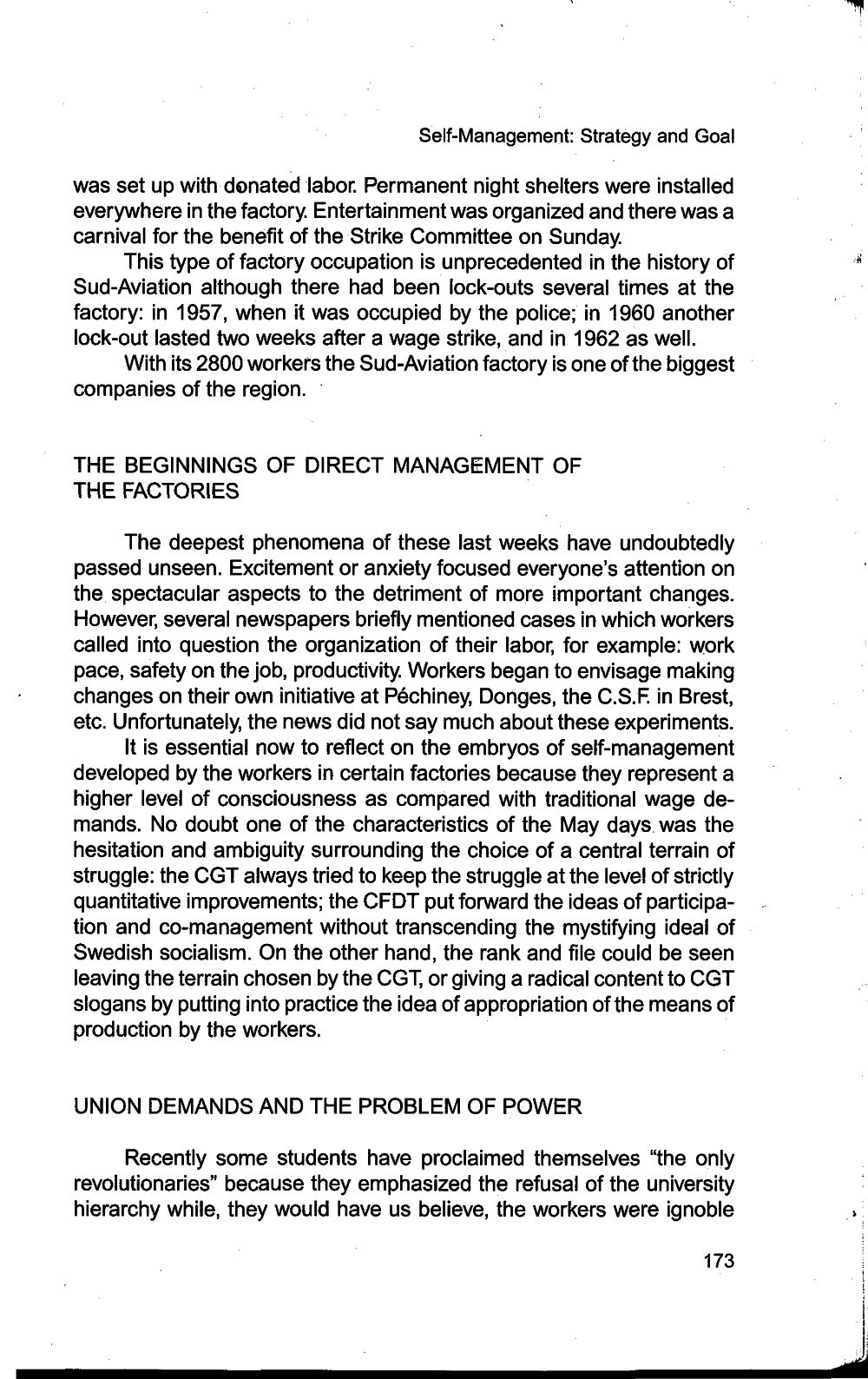

Self-Management: Strategy and Goal
was set up with donated labor. Permanent night shelters were installed
everywhere in the factory. Entertainment was organized and there was a
carnival for the benefit of the Strike Committee on Sunday.
everywhere in the factory. Entertainment was organized and there was a
carnival for the benefit of the Strike Committee on Sunday.
This type of factory occupation is unprecedented in the history of
Sud-Aviation although there had been lock-outs several times at the
factory: in 1957, when it was occupied by the police; in 1960 another
lock-out lasted two weeks after a wage strike, and in 1962 as well.
Sud-Aviation although there had been lock-outs several times at the
factory: in 1957, when it was occupied by the police; in 1960 another
lock-out lasted two weeks after a wage strike, and in 1962 as well.
With its 2800 workers the Sud-Aviation factory is one of the biggest
companies of the region.
companies of the region.
THE BEGINNINGS OF DIRECT MANAGEMENT OF
THE FACTORIES
THE FACTORIES
The deepest phenomena of these last weeks have undoubtedly
passed unseen. Excitement or anxiety focused everyone's attention on
the spectacular aspects to the detriment of more important changes.
However, several newspapers briefly mentioned cases in which workers
called into question the organization of their labor, for example: work
pace, safety on the job, productivity. Workers began to envisage making
changes on their own initiative at Pechiney, Donges, the C.S.F. in Brest,
etc. Unfortunately, the news did not say much about these experiments.
passed unseen. Excitement or anxiety focused everyone's attention on
the spectacular aspects to the detriment of more important changes.
However, several newspapers briefly mentioned cases in which workers
called into question the organization of their labor, for example: work
pace, safety on the job, productivity. Workers began to envisage making
changes on their own initiative at Pechiney, Donges, the C.S.F. in Brest,
etc. Unfortunately, the news did not say much about these experiments.
It is essential now to reflect on the embryos of self-management
developed by the workers in certain factories because they represent a
higher level of consciousness as compared with traditional wage de-
mands. No doubt one of the characteristics of the May days was the
hesitation and ambiguity surrounding the choice of a central terrain of
struggle: the CGT always tried to keep the struggle at the level of strictly
quantitative improvements; the CFDT put forward the ideas of participa-
tion and co-management without transcending the mystifying ideal of
Swedish socialism. On the other hand, the rank and file could be seen
leaving the terrain chosen by the CGT, or giving a radical content to CGT
slogans by putting into practice the idea of appropriation of the means of
production by the workers.
developed by the workers in certain factories because they represent a
higher level of consciousness as compared with traditional wage de-
mands. No doubt one of the characteristics of the May days was the
hesitation and ambiguity surrounding the choice of a central terrain of
struggle: the CGT always tried to keep the struggle at the level of strictly
quantitative improvements; the CFDT put forward the ideas of participa-
tion and co-management without transcending the mystifying ideal of
Swedish socialism. On the other hand, the rank and file could be seen
leaving the terrain chosen by the CGT, or giving a radical content to CGT
slogans by putting into practice the idea of appropriation of the means of
production by the workers.
UNION DEMANDS AND THE PROBLEM OF POWER
Recently some students have proclaimed themselves "the only
revolutionaries" because they emphasized the refusal of the university
hierarchy while, they would have us believe, the workers were ignoble
revolutionaries" because they emphasized the refusal of the university
hierarchy while, they would have us believe, the workers were ignoble
173
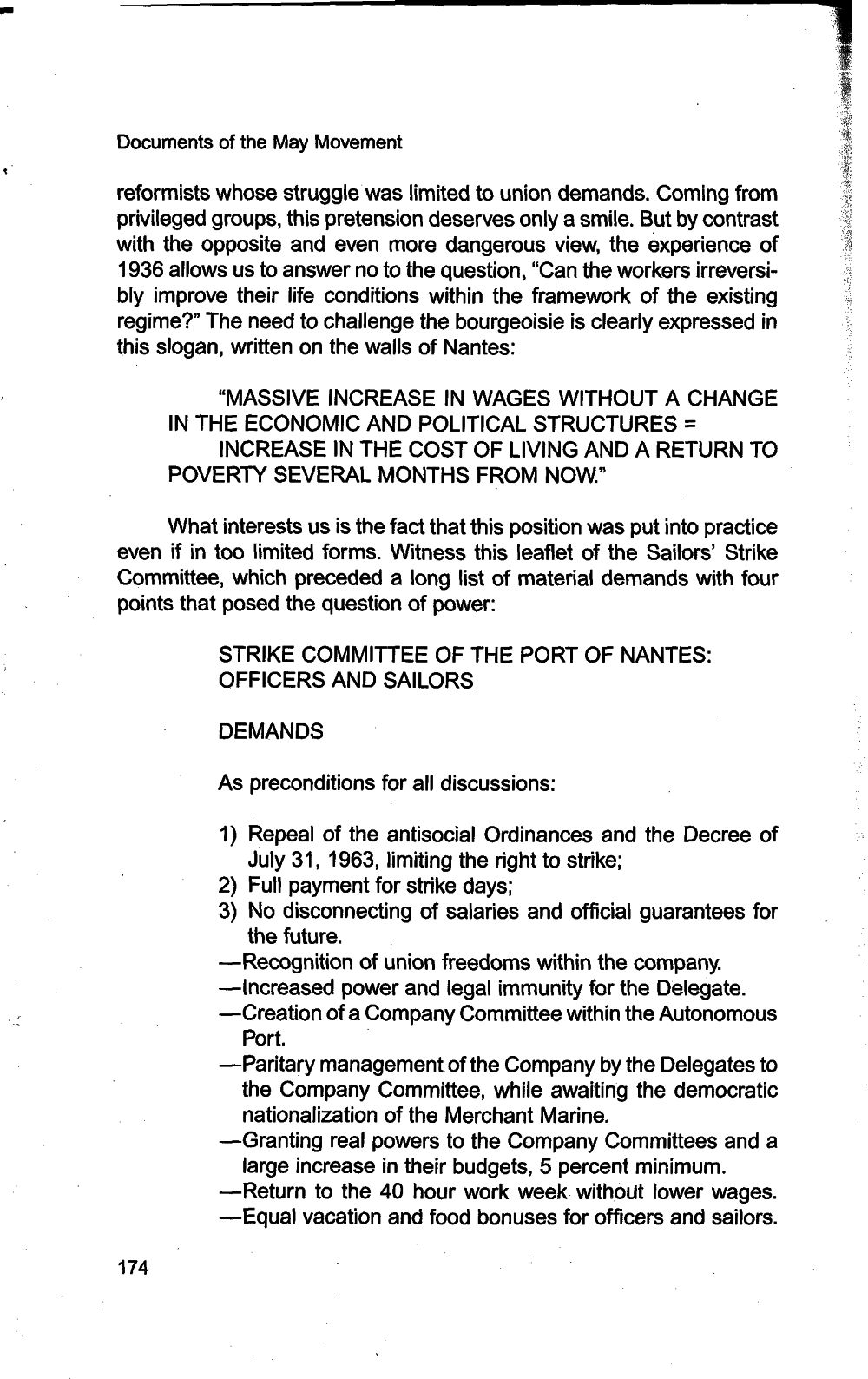

Documents of the May Movement
reformists whose struggle was limited to union demands. Coming from
privileged groups, this pretension deserves only a smile. But by contrast
with the opposite and even more dangerous view, the experience of
1936 allows us to answer no to the question, "Can the workers irreversi-
bly improve their life conditions within the framework of the existing
regime?" The need to challenge the bourgeoisie is clearly expressed in
this slogan, written on the walls of Nantes:
privileged groups, this pretension deserves only a smile. But by contrast
with the opposite and even more dangerous view, the experience of
1936 allows us to answer no to the question, "Can the workers irreversi-
bly improve their life conditions within the framework of the existing
regime?" The need to challenge the bourgeoisie is clearly expressed in
this slogan, written on the walls of Nantes:
"MASSIVE INCREASE IN WAGES WITHOUT A CHANGE
IN THE ECONOMIC AND POLITICAL STRUCTURES =
IN THE ECONOMIC AND POLITICAL STRUCTURES =
INCREASE IN THE COST OF LIVING AND A RETURN TO
POVERTY SEVERAL MONTHS FROM NOW."
POVERTY SEVERAL MONTHS FROM NOW."
What interests us is the fact that this position was put into practice
even if in too limited forms. Witness this leaflet of the Sailors' Strike
Committee, which preceded a long list of material demands with four
points that posed the question of power:
even if in too limited forms. Witness this leaflet of the Sailors' Strike
Committee, which preceded a long list of material demands with four
points that posed the question of power:
STRIKE COMMITTEE OF THE PORT OF NANTES:
OFFICERS AND SAILORS
OFFICERS AND SAILORS
DEMANDS
As preconditions for all discussions:
1) Repeal of the antisocial Ordinances and the Decree of
July 31, 1963, limiting the right to strike;
July 31, 1963, limiting the right to strike;
2) Full payment for strike days;
3) No disconnecting of salaries and official guarantees for
the future.
the future.
—Recognition of union freedoms within the company.
—Increased power and legal immunity for the Delegate.
—Creation of a Company Committee within the Autonomous
—Increased power and legal immunity for the Delegate.
—Creation of a Company Committee within the Autonomous
Port.
—Paritary management of the Company by the Delegates to
—Paritary management of the Company by the Delegates to
the Company Committee, while awaiting the democratic
nationalization of the Merchant Marine.
—Granting real powers to the Company Committees and a
—Granting real powers to the Company Committees and a
large increase in their budgets, 5 percent minimum.
—Return to the 40 hour work week without lower wages.
—Equal vacation and food bonuses for officers and sailors.
—Return to the 40 hour work week without lower wages.
—Equal vacation and food bonuses for officers and sailors.
174

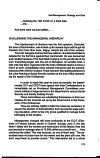
Self-Management: Strategy and Goal
—Granting the 13th month on a fixed date.
—Etc. ...
—Etc. ...
And there were not just leaflets. . . .
CHALLENGING THE MANAGERIAL HIERARCHY
The imprisonment of directors was the first symptom. Duvochel,
the boss at Sud-Aviation, was locked up for several days until he got his
freedom from that other boss, Seguy, despite the will of the workers.
the boss at Sud-Aviation, was locked up for several days until he got his
freedom from that other boss, Seguy, despite the will of the workers.
The CGT delegate Andrieu told how sailors in the Merchant Marine
rebelled for the first time against their commander. He was denounced
and insulted because of his bad habit of spying on the private life of his
men. Everything began with this act of disrespect. On another boat, a
fake vote had been organized with the help of illiterate blacks to force a
return to work. Immediately, thirty activists intervened and the subordi-
nates put their chief in his place. A last example: this leaflet published by
the Loire-Atlantique Social Security workers at the end of May demand-
ing the repeal of the Ordinances:
rebelled for the first time against their commander. He was denounced
and insulted because of his bad habit of spying on the private life of his
men. Everything began with this act of disrespect. On another boat, a
fake vote had been organized with the help of illiterate blacks to force a
return to work. Immediately, thirty activists intervened and the subordi-
nates put their chief in his place. A last example: this leaflet published by
the Loire-Atlantique Social Security workers at the end of May demand-
ing the repeal of the Ordinances:
In order to reach this goal as soon as possible, the depart-
mental CGT and CFDT have agreed with their Confederations to
immediately set up Provisional Management Committees com-
posed entirely of wage earners in the department's various Social
Security and Family Subsidy Funds.
mental CGT and CFDT have agreed with their Confederations to
immediately set up Provisional Management Committees com-
posed entirely of wage earners in the department's various Social
Security and Family Subsidy Funds.
These Committees are substituting themselves on their own
initiative for the Councils set up by the Government in the frame-
work of the Ordinances.
initiative for the Councils set up by the Government in the frame-
work of the Ordinances.
They are working rapidly to take the measures necessary to
assure the election of Administrators from among the wage earn-
ing population, which is the only group qualified to manage funds
belonging to the workers.
assure the election of Administrators from among the wage earn-
ing population, which is the only group qualified to manage funds
belonging to the workers.
Management changed still more profoundly at the E.D.F. (Elec-
tricity of France) thermic center in Chevire. Sunday, June 2, the day
when I talked with the workers and technicians of this factory, they had
just received an average raise of 15,000 old francs a month and . . . they
continued the strike! This was because, as one of them said: "The ex-
ecutives have not been here for two weeks and the plant still runs. We
don't need them to provide current." This intervention led to a whole
tricity of France) thermic center in Chevire. Sunday, June 2, the day
when I talked with the workers and technicians of this factory, they had
just received an average raise of 15,000 old francs a month and . . . they
continued the strike! This was because, as one of them said: "The ex-
ecutives have not been here for two weeks and the plant still runs. We
don't need them to provide current." This intervention led to a whole
175
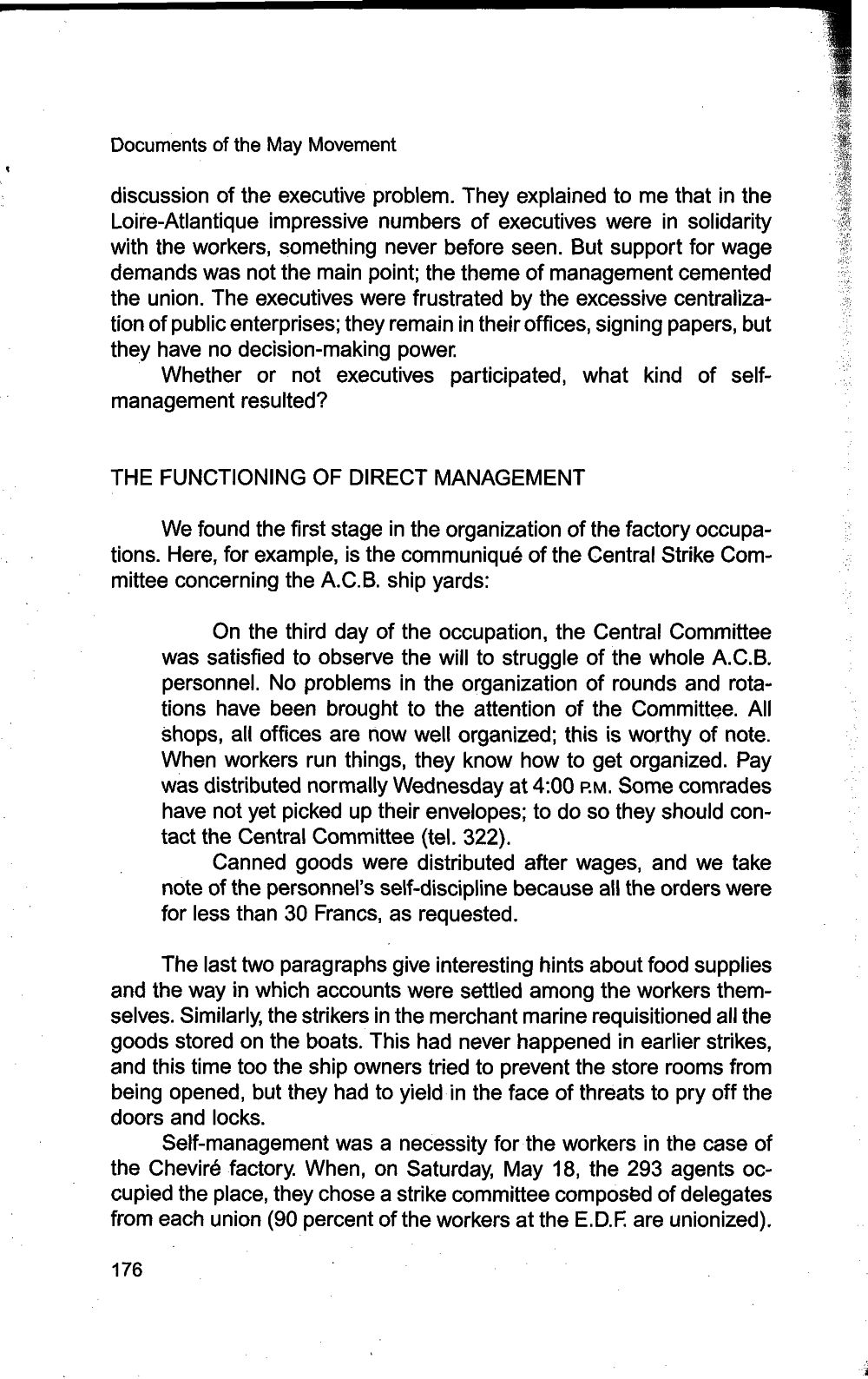

Documents of the May Movement
discussion of the executive problem. They explained to me that in the
Loire-Atlantique impressive numbers of executives were in solidarity
with the workers, something never before seen. But support for wage
demands was not the main point; the theme of management cemented
the union. The executives were frustrated by the excessive centraliza-
tion of public enterprises; they remain in their offices, signing papers, but
they have no decision-making power.
Loire-Atlantique impressive numbers of executives were in solidarity
with the workers, something never before seen. But support for wage
demands was not the main point; the theme of management cemented
the union. The executives were frustrated by the excessive centraliza-
tion of public enterprises; they remain in their offices, signing papers, but
they have no decision-making power.
Whether or not executives participated, what kind of self-
management resulted?
management resulted?
THE FUNCTIONING OF DIRECT MANAGEMENT
We found the first stage in the organization of the factory occupa-
tions. Here, for example, is the communique of the Central Strike Com-
mittee concerning the A.C.B. ship yards:
tions. Here, for example, is the communique of the Central Strike Com-
mittee concerning the A.C.B. ship yards:
On the third day of the occupation, the Central Committee
was satisfied to observe the will to struggle of the whole A.C.B.
personnel. No problems in the organization of rounds and rota-
tions have been brought to the attention of the Committee. All
shops, all offices are now well organized; this is worthy of note.
When workers run things, they know how to get organized. Pay
was distributed normally Wednesday at 4:00 P.M. Some comrades
have not yet picked up their envelopes; to do so they should con-
tact the Central Committee (tel. 322).
was satisfied to observe the will to struggle of the whole A.C.B.
personnel. No problems in the organization of rounds and rota-
tions have been brought to the attention of the Committee. All
shops, all offices are now well organized; this is worthy of note.
When workers run things, they know how to get organized. Pay
was distributed normally Wednesday at 4:00 P.M. Some comrades
have not yet picked up their envelopes; to do so they should con-
tact the Central Committee (tel. 322).
Canned goods were distributed after wages, and we take
note of the personnel's self-discipline because all the orders were
for less than 30 Francs, as requested.
note of the personnel's self-discipline because all the orders were
for less than 30 Francs, as requested.
The last two paragraphs give interesting hints about food supplies
and the way in which accounts were settled among the workers them-
selves. Similarly, the strikers in the merchant marine requisitioned all the
goods stored on the boats. This had never happened in earlier strikes,
and this time too the ship owners tried to prevent the store rooms from
being opened, but they had to yield in the face of threats to pry off the
doors and locks.
and the way in which accounts were settled among the workers them-
selves. Similarly, the strikers in the merchant marine requisitioned all the
goods stored on the boats. This had never happened in earlier strikes,
and this time too the ship owners tried to prevent the store rooms from
being opened, but they had to yield in the face of threats to pry off the
doors and locks.
Self-management was a necessity for the workers in the case of
the Chevir6 factory. When, on Saturday, May 18, the 293 agents oc-
cupied the place, they chose a strike committee composed of delegates
from each union (90 percent of the workers at the E.D.F are unionized).
the Chevir6 factory. When, on Saturday, May 18, the 293 agents oc-
cupied the place, they chose a strike committee composed of delegates
from each union (90 percent of the workers at the E.D.F are unionized).
176
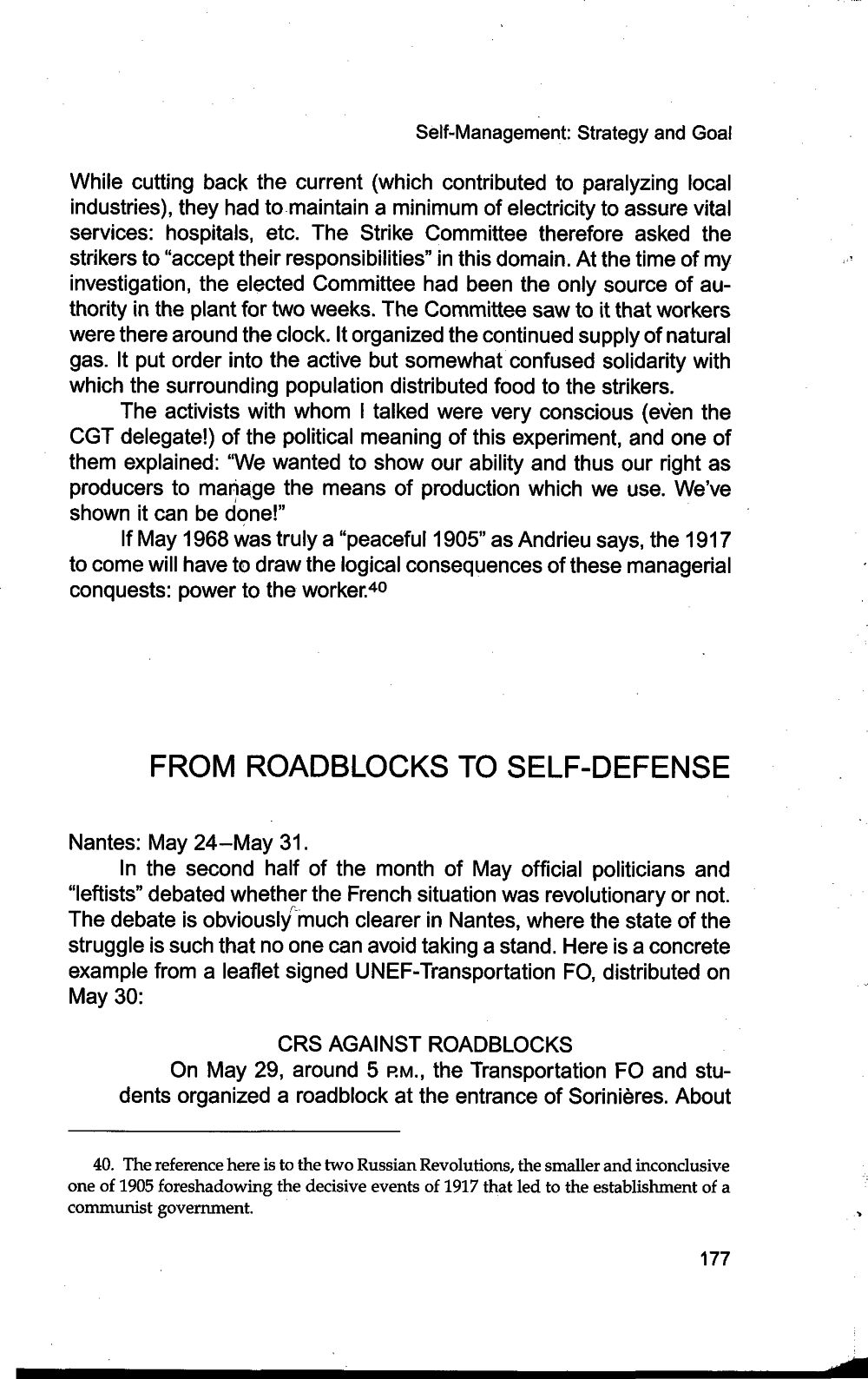

Self-Management: Strategy and Goal
While cutting back the current (which contributed to paralyzing local
industries), they had to maintain a minimum of electricity to assure vital
services: hospitals, etc. The Strike Committee therefore asked the
strikers to "accept their responsibilities" in this domain. At the time of my
investigation, the elected Committee had been the only source of au-
thority in the plant for two weeks. The Committee saw to it that workers
were there around the clock. It organized the continued supply of natural
gas. It put order into the active but somewhat confused solidarity with
which the surrounding population distributed food to the strikers.
industries), they had to maintain a minimum of electricity to assure vital
services: hospitals, etc. The Strike Committee therefore asked the
strikers to "accept their responsibilities" in this domain. At the time of my
investigation, the elected Committee had been the only source of au-
thority in the plant for two weeks. The Committee saw to it that workers
were there around the clock. It organized the continued supply of natural
gas. It put order into the active but somewhat confused solidarity with
which the surrounding population distributed food to the strikers.
The activists with whom I talked were very conscious (even the
CGT delegate!) of the political meaning of this experiment, and one of
them explained: "We wanted to show our ability and thus our right as
producers to manage the means of production which we use. We've
shown it can be done!"
CGT delegate!) of the political meaning of this experiment, and one of
them explained: "We wanted to show our ability and thus our right as
producers to manage the means of production which we use. We've
shown it can be done!"
If May 1968 was truly a "peaceful 1905" as Andrieu says, the 1917
to come will have to draw the logical consequences of these managerial
conquests: power to the worker.40
to come will have to draw the logical consequences of these managerial
conquests: power to the worker.40
FROM ROADBLOCKS TO SELF-DEFENSE
Nantes: May 24-May 31.
In the second half of the month of May official politicians and
"leftists" debated whether the French situation was revolutionary or not.
The debate is obviously much clearer in Nantes, where the state of the
struggle is such that no one can avoid taking a stand. Here is a concrete
example from a leaflet signed UNEF-Transportation FO, distributed on
May 30:
"leftists" debated whether the French situation was revolutionary or not.
The debate is obviously much clearer in Nantes, where the state of the
struggle is such that no one can avoid taking a stand. Here is a concrete
example from a leaflet signed UNEF-Transportation FO, distributed on
May 30:
CRS AGAINST ROADBLOCKS
On May 29, around 5 P.M., the Transportation FO and stu-
dents organized a roadblock at the entrance of Sorinieres. About
dents organized a roadblock at the entrance of Sorinieres. About
40. The reference here is to the two Russian Revolutions, the smaller and inconclusive
one of 1905 foreshadowing the decisive events of 1917 that led to the establishment of a
communist government.
one of 1905 foreshadowing the decisive events of 1917 that led to the establishment of a
communist government.
177
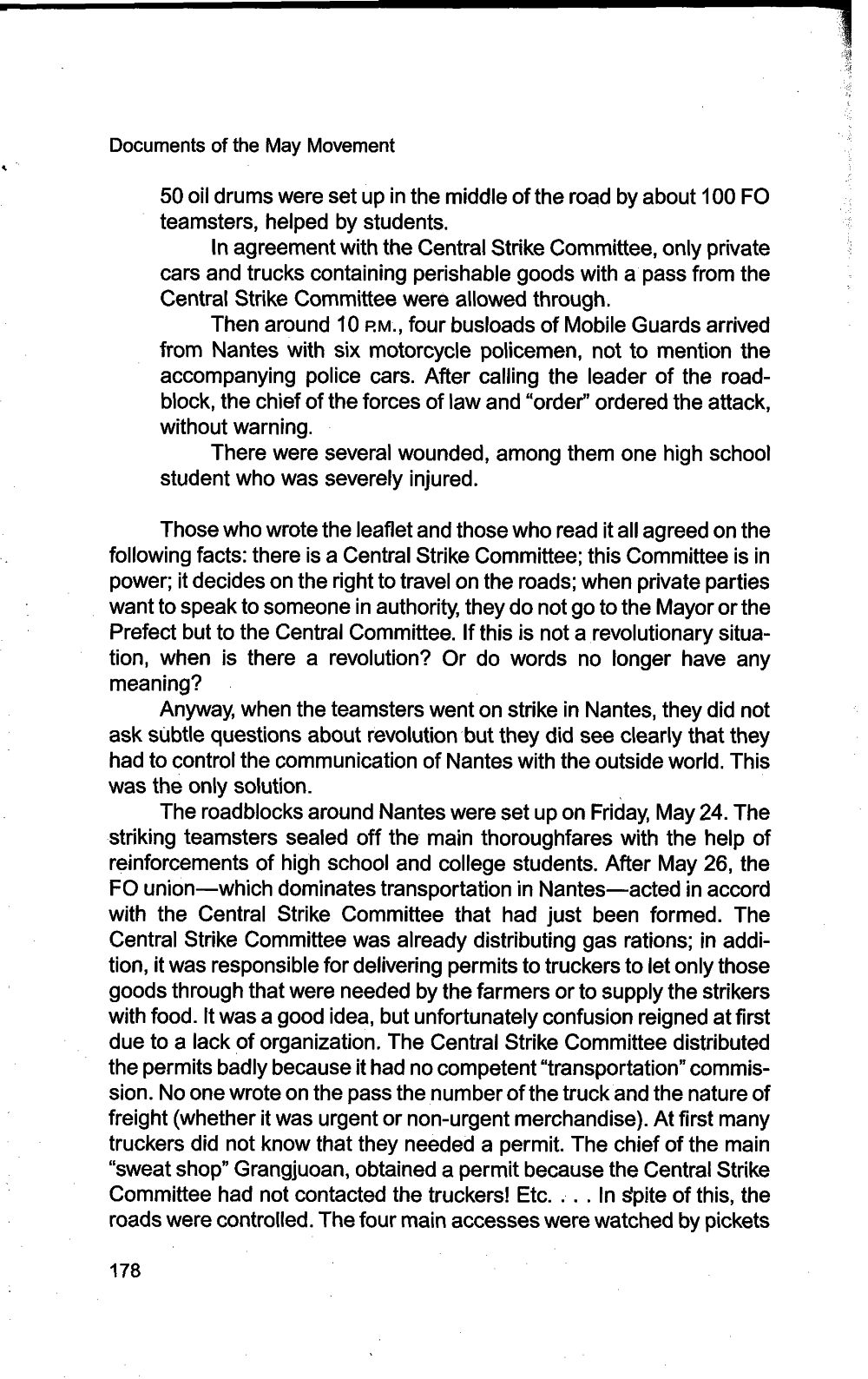

Documents of the May Movement
50 oil drums were set up in the middle of the road by about 100 FO
teamsters, helped by students.
teamsters, helped by students.
In agreement with the Central Strike Committee, only private
cars and trucks containing perishable goods with a pass from the
Central Strike Committee were allowed through.
cars and trucks containing perishable goods with a pass from the
Central Strike Committee were allowed through.
Then around 10 P.M., four busloads of Mobile Guards arrived
from Nantes with six motorcycle policemen, not to mention the
accompanying police cars. After calling the leader of the road-
block, the chief of the forces of law and "order" ordered the attack,
without warning.
from Nantes with six motorcycle policemen, not to mention the
accompanying police cars. After calling the leader of the road-
block, the chief of the forces of law and "order" ordered the attack,
without warning.
There were several wounded, among them one high school
student who was severely injured.
student who was severely injured.
Those who wrote the leaflet and those who read it all agreed on the
following facts: there is a Central Strike Committee; this Committee is in
power; it decides on the right to travel on the roads; when private parties
want to speak to someone in authority, they do not go to the Mayor or the
Prefect but to the Central Committee. If this is not a revolutionary situa-
tion, when is there a revolution? Or do words no longer have any
meaning?
following facts: there is a Central Strike Committee; this Committee is in
power; it decides on the right to travel on the roads; when private parties
want to speak to someone in authority, they do not go to the Mayor or the
Prefect but to the Central Committee. If this is not a revolutionary situa-
tion, when is there a revolution? Or do words no longer have any
meaning?
Anyway, when the teamsters went on strike in Nantes, they did not
ask subtle questions about revolution but they did see clearly that they
had to control the communication of Nantes with the outside world. This
was the only solution.
ask subtle questions about revolution but they did see clearly that they
had to control the communication of Nantes with the outside world. This
was the only solution.
The roadblocks around Nantes were set up on Friday, May 24. The
striking teamsters sealed off the main thoroughfares with the help of
reinforcements of high school and college students. After May 26, the
FO union—which dominates transportation in Nantes—acted in accord
with the Central Strike Committee that had just been formed. The
Central Strike Committee was already distributing gas rations; in addi-
tion, it was responsible for delivering permits to truckers to let only those
goods through that were needed by the farmers or to supply the strikers
with food. It was a good idea, but unfortunately confusion reigned at first
due to a lack of organization. The Central Strike Committee distributed
the permits badly because it had no competent "transportation" commis-
sion. No one wrote on the pass the number of the truck and the nature of
freight (whether it was urgent or non-urgent merchandise). At first many
truckers did not know that they needed a permit. The chief of the main
"sweat shop" Grangjuoan, obtained a permit because the Central Strike
Committee had not contacted the truckers! Etc. ... In s'pite of this, the
roads were controlled. The four main accesses were watched by pickets
striking teamsters sealed off the main thoroughfares with the help of
reinforcements of high school and college students. After May 26, the
FO union—which dominates transportation in Nantes—acted in accord
with the Central Strike Committee that had just been formed. The
Central Strike Committee was already distributing gas rations; in addi-
tion, it was responsible for delivering permits to truckers to let only those
goods through that were needed by the farmers or to supply the strikers
with food. It was a good idea, but unfortunately confusion reigned at first
due to a lack of organization. The Central Strike Committee distributed
the permits badly because it had no competent "transportation" commis-
sion. No one wrote on the pass the number of the truck and the nature of
freight (whether it was urgent or non-urgent merchandise). At first many
truckers did not know that they needed a permit. The chief of the main
"sweat shop" Grangjuoan, obtained a permit because the Central Strike
Committee had not contacted the truckers! Etc. ... In s'pite of this, the
roads were controlled. The four main accesses were watched by pickets
178

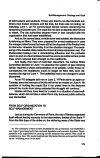
Self-Management: Strategy and Goal
of 500 truckers and students. Those who tried to run the blockade suf-
fered a few broken windows and flat tires, but there was no looting: on
Saturday, June 1, an FO communique denied rumors concerning the
ransoming of private cars. The cops did not dare to disperse their forces
to attack. The city authorities became more or less complicit with the
organization that had been established.
fered a few broken windows and flat tires, but there was no looting: on
Saturday, June 1, an FO communique denied rumors concerning the
ransoming of private cars. The cops did not dare to disperse their forces
to attack. The city authorities became more or less complicit with the
organization that had been established.
And so, for several days, a whole town was isolated, the blockades
functioning as filters. They even prepared for armed resistance in case
the meager police forces that were still at the disposal of the Prefect tried
to intervene. However, from May 31 on the situation changed. The awak-
ening of the Gaullist state made the threat of police repression real. The
Pentecostal holidays had a demobilizing influence and the probable
return to work in a few factories forced the unions to reinforce their picket
lines, which reduced their strength on the roadblocks.
functioning as filters. They even prepared for armed resistance in case
the meager police forces that were still at the disposal of the Prefect tried
to intervene. However, from May 31 on the situation changed. The awak-
ening of the Gaullist state made the threat of police repression real. The
Pentecostal holidays had a demobilizing influence and the probable
return to work in a few factories forced the unions to reinforce their picket
lines, which reduced their strength on the roadblocks.
And finally, from fear of motorists' discontent, the Central Strike
Committee decided on June 1 to abandon the system of gas rationing
(which required a whole administration of 40 people). Under those cir-
cumstances, the roadblocks could no longer be held; they were dis-
mantled the night of June 1. The battlefield had to be changed to avoid
bloodshed.
Committee decided on June 1 to abandon the system of gas rationing
(which required a whole administration of 40 people). Under those cir-
cumstances, the roadblocks could no longer be held; they were dis-
mantled the night of June 1. The battlefield had to be changed to avoid
bloodshed.
As an FO delegate told me on June 2, "If Paris starts up again on
Tuesday, escorted convoys of trucks will arrive en masse on June 4. No
question of holding the roads! But if our picket lines in the factories
prevent the trucks from being unloaded the struggle will continue."
Tuesday, escorted convoys of trucks will arrive en masse on June 4. No
question of holding the roads! But if our picket lines in the factories
prevent the trucks from being unloaded the struggle will continue."
Nantes will thus have lived for a week in a situation of semi-self-
defense, which did not take a violent form only because public authority
was dismantled.
defense, which did not take a violent form only because public authority
was dismantled.
FROM SELF-ORGANIZATION TO
SELF-MANAGEMENT
SELF-MANAGEMENT
Just as during the Commune of Paris, the city of Nantes organized
itself without having recourse to the intermediary bodies of the State.41
From the first days of the strike on, the withering away of the State was
itself without having recourse to the intermediary bodies of the State.41
From the first days of the strike on, the withering away of the State was
41. The Commune of Paris in 1871 abolished the city government and established a
new type of governing body that combined legislative and executive functions. Repre-
sentatives were responsible for carrying out the measures they passed. They could be
recalled at any time. This model inspired later libertarian Marxist and anarchist thinking
on the "withering away of the state."
new type of governing body that combined legislative and executive functions. Repre-
sentatives were responsible for carrying out the measures they passed. They could be
recalled at any time. This model inspired later libertarian Marxist and anarchist thinking
on the "withering away of the state."
179
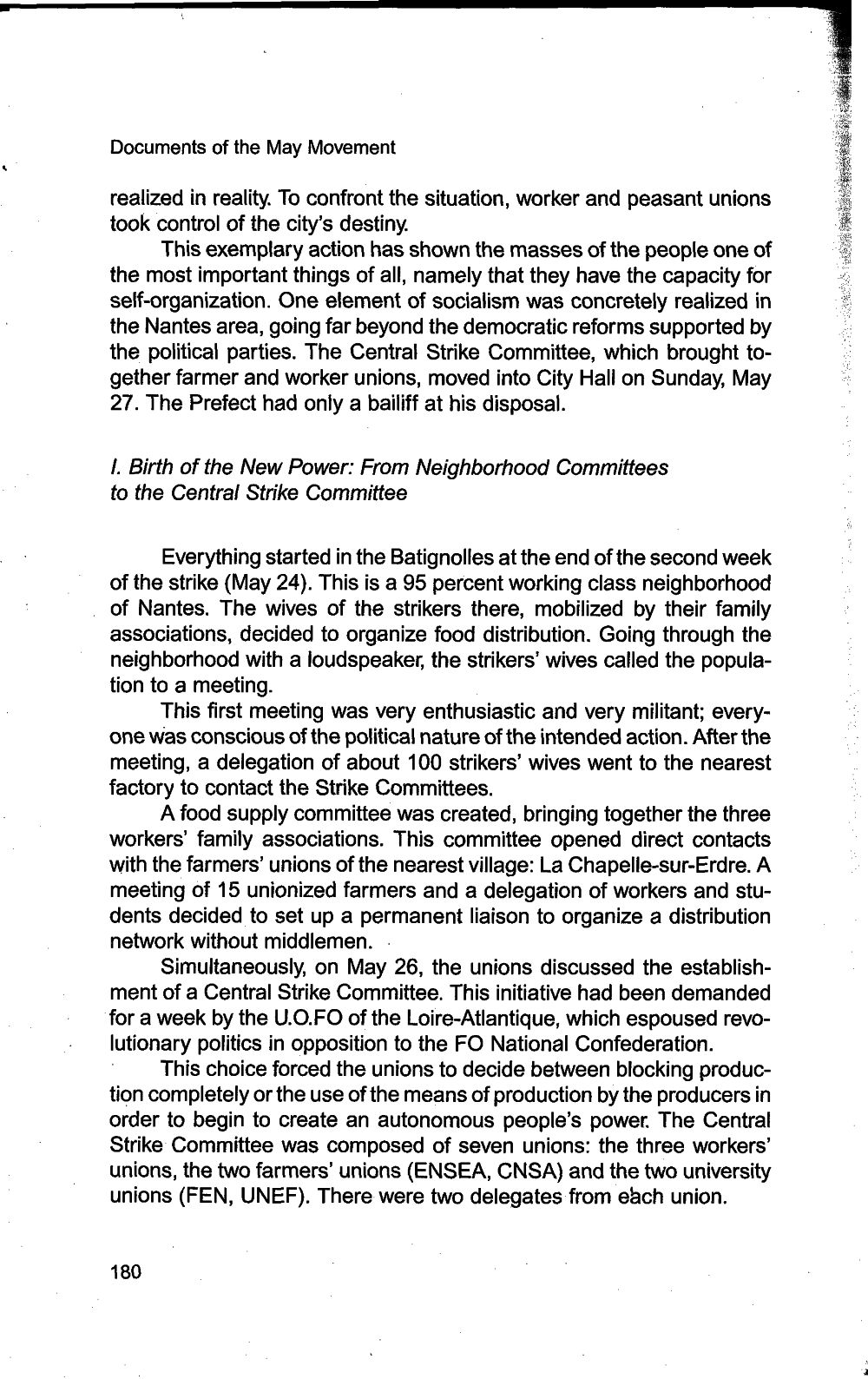

Documents of the May Movement
realized in reality. To confront the situation, worker and peasant unions
took control of the city's destiny.
took control of the city's destiny.
This exemplary action has shown the masses of the people one of
the most important things of all, namely that they have the capacity for
self-organization. One element of socialism was concretely realized in
the Nantes area, going far beyond the democratic reforms supported by
the political parties. The Central Strike Committee, which brought to-
gether farmer and worker unions, moved into City Hall on Sunday, May
27. The Prefect had only a bailiff at his disposal.
the most important things of all, namely that they have the capacity for
self-organization. One element of socialism was concretely realized in
the Nantes area, going far beyond the democratic reforms supported by
the political parties. The Central Strike Committee, which brought to-
gether farmer and worker unions, moved into City Hall on Sunday, May
27. The Prefect had only a bailiff at his disposal.
/. Birth of the New Power: From Neighborhood Committees
to the Central Strike Committee
to the Central Strike Committee
Everything started in the Batignolles at the end of the second week
of the strike (May 24). This is a 95 percent working class neighborhood
of Nantes. The wives of the strikers there, mobilized by their family
associations, decided to organize food distribution. Going through the
neighborhood with a loudspeaker, the strikers' wives called the popula-
tion to a meeting.
of the strike (May 24). This is a 95 percent working class neighborhood
of Nantes. The wives of the strikers there, mobilized by their family
associations, decided to organize food distribution. Going through the
neighborhood with a loudspeaker, the strikers' wives called the popula-
tion to a meeting.
This first meeting was very enthusiastic and very militant; every-
one was conscious of the political nature of the intended action. After the
meeting, a delegation of about 100 strikers' wives went to the nearest
factory to contact the Strike Committees.
one was conscious of the political nature of the intended action. After the
meeting, a delegation of about 100 strikers' wives went to the nearest
factory to contact the Strike Committees.
A food supply committee was created, bringing together the three
workers' family associations. This committee opened direct contacts
with the farmers' unions of the nearest village: La Chapelle-sur-Erdre. A
meeting of 15 unionized farmers and a delegation of workers and stu-
dents decided to set up a permanent liaison to organize a distribution
network without middlemen.
workers' family associations. This committee opened direct contacts
with the farmers' unions of the nearest village: La Chapelle-sur-Erdre. A
meeting of 15 unionized farmers and a delegation of workers and stu-
dents decided to set up a permanent liaison to organize a distribution
network without middlemen.
Simultaneously, on May 26, the unions discussed the establish-
ment of a Central Strike Committee. This initiative had been demanded
for a week by the U.O.FO of the Loire-Atlantique, which espoused revo-
lutionary politics in opposition to the FO National Confederation.
ment of a Central Strike Committee. This initiative had been demanded
for a week by the U.O.FO of the Loire-Atlantique, which espoused revo-
lutionary politics in opposition to the FO National Confederation.
This choice forced the unions to decide between blocking produc-
tion completely or the use of the means of production by the producers in
order to begin to create an autonomous people's power. The Central
Strike Committee was composed of seven unions: the three workers'
unions, the two farmers' unions (ENSEA, CNSA) and the two university
unions (FEN, UNEF). There were two delegates from each union.
tion completely or the use of the means of production by the producers in
order to begin to create an autonomous people's power. The Central
Strike Committee was composed of seven unions: the three workers'
unions, the two farmers' unions (ENSEA, CNSA) and the two university
unions (FEN, UNEF). There were two delegates from each union.
180
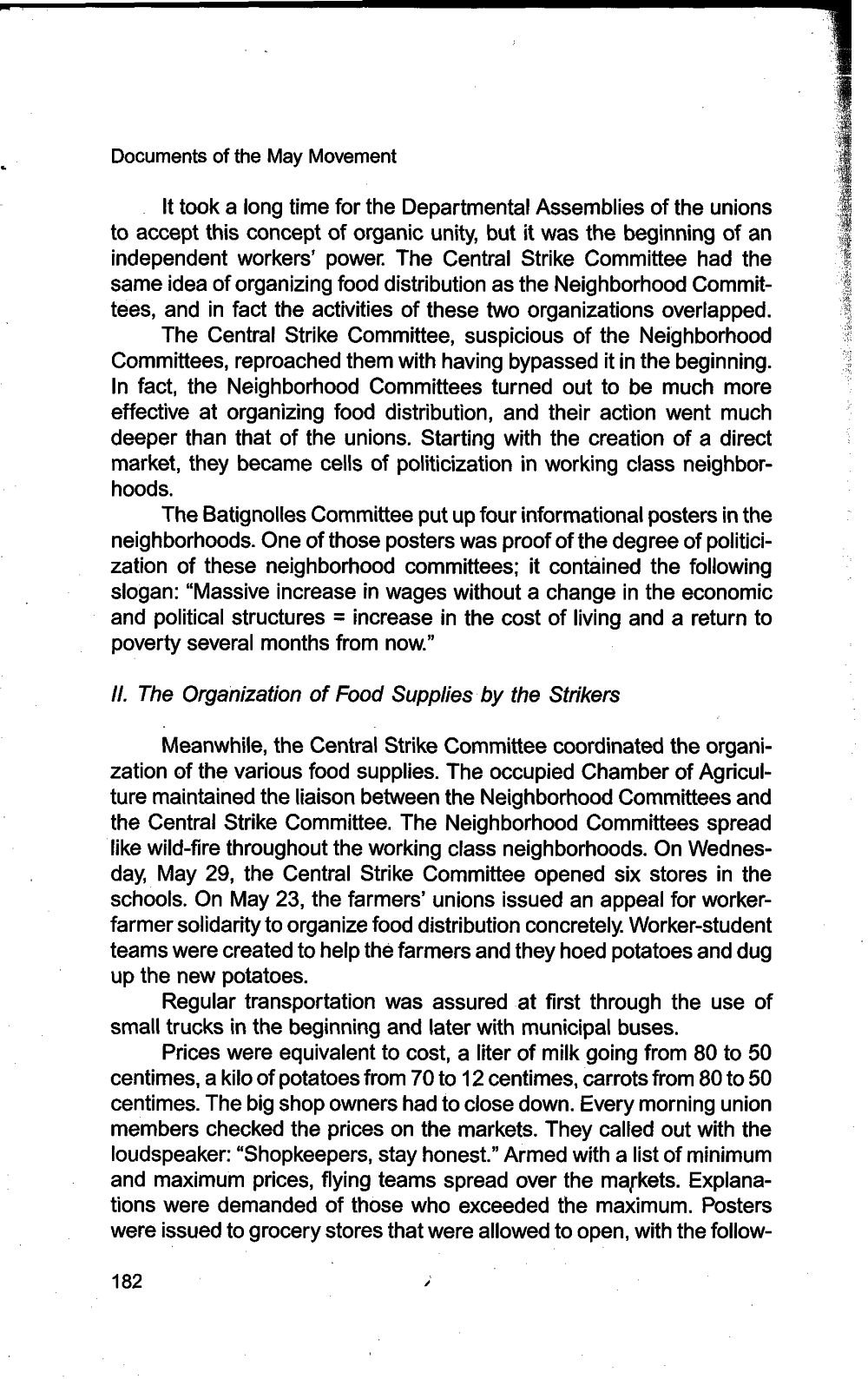

Documents of the May Movement
It took a long time for the Departmental Assemblies of the unions
to accept this concept of organic unity, but it was the beginning of an
independent workers' power. The Central Strike Committee had the
same idea of organizing food distribution as the Neighborhood Commit-
tees, and in fact the activities of these two organizations overlapped.
to accept this concept of organic unity, but it was the beginning of an
independent workers' power. The Central Strike Committee had the
same idea of organizing food distribution as the Neighborhood Commit-
tees, and in fact the activities of these two organizations overlapped.
The Central Strike Committee, suspicious of the Neighborhood
Committees, reproached them with having bypassed it in the beginning.
In fact, the Neighborhood Committees turned out to be much more
effective at organizing food distribution, and their action went much
deeper than that of the unions. Starting with the creation of a direct
market, they became cells of politicization in working class neighbor-
hoods.
Committees, reproached them with having bypassed it in the beginning.
In fact, the Neighborhood Committees turned out to be much more
effective at organizing food distribution, and their action went much
deeper than that of the unions. Starting with the creation of a direct
market, they became cells of politicization in working class neighbor-
hoods.
The Batignolles Committee put up four informational posters in the
neighborhoods. One of those posters was proof of the degree of politici-
zation of these neighborhood committees; it contained the following
slogan: "Massive increase in wages without a change in the economic
and political structures = increase in the cost of living and a return to
poverty several months from now."
neighborhoods. One of those posters was proof of the degree of politici-
zation of these neighborhood committees; it contained the following
slogan: "Massive increase in wages without a change in the economic
and political structures = increase in the cost of living and a return to
poverty several months from now."
//. The Organization of Food Supplies by the Strikers
Meanwhile, the Central Strike Committee coordinated the organi-
zation of the various food supplies. The occupied Chamber of Agricul-
ture maintained the liaison between the Neighborhood Committees and
the Central Strike Committee. The Neighborhood Committees spread
like wild-fire throughout the working class neighborhoods. On Wednes-
day, May 29, the Central Strike Committee opened six stores in the
schools. On May 23, the farmers' unions issued an appeal for worker-
farmer solidarity to organize food distribution concretely. Worker-student
teams were created to help the farmers and they hoed potatoes and dug
up the new potatoes.
zation of the various food supplies. The occupied Chamber of Agricul-
ture maintained the liaison between the Neighborhood Committees and
the Central Strike Committee. The Neighborhood Committees spread
like wild-fire throughout the working class neighborhoods. On Wednes-
day, May 29, the Central Strike Committee opened six stores in the
schools. On May 23, the farmers' unions issued an appeal for worker-
farmer solidarity to organize food distribution concretely. Worker-student
teams were created to help the farmers and they hoed potatoes and dug
up the new potatoes.
Regular transportation was assured at first through the use of
small trucks in the beginning and later with municipal buses.
small trucks in the beginning and later with municipal buses.
Prices were equivalent to cost, a liter of milk going from 80 to 50
centimes, a kilo of potatoes from 70 to 12 centimes, carrots from 80 to 50
centimes. The big shop owners had to close down. Every morning union
members checked the prices on the markets. They called out with the
loudspeaker: "Shopkeepers, stay honest." Armed with a list of minimum
and maximum prices, flying teams spread over the markets. Explana-
tions were demanded of those who exceeded the maximum. Posters
were issued to grocery stores that were allowed to open, with the follow-
centimes, a kilo of potatoes from 70 to 12 centimes, carrots from 80 to 50
centimes. The big shop owners had to close down. Every morning union
members checked the prices on the markets. They called out with the
loudspeaker: "Shopkeepers, stay honest." Armed with a list of minimum
and maximum prices, flying teams spread over the markets. Explana-
tions were demanded of those who exceeded the maximum. Posters
were issued to grocery stores that were allowed to open, with the follow-
182

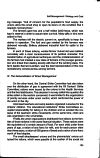
Self-Management: Strategy and Goal
ing message: "Out of concern for the population's food supply, the
unions allow this small shop to open its doors on the condition that it
respects normal prices."
unions allow this small shop to open its doors on the condition that it
respects normal prices."
The farmers gave two and a half million [old] francs, which was
kept in reserve in order to assure later survival. Many gifts in kind were
added to that.
kept in reserve in order to assure later survival. Many gifts in kind were
added to that.
The workers left the electric current on, specifically to keep the
dairies in operation. The fuel and gas needed by the farmers was
delivered normally. Strikers delivered industrial food for cattle to the
farmers.
dairies in operation. The fuel and gas needed by the farmers was
delivered normally. Strikers delivered industrial food for cattle to the
farmers.
In each of these actions, worker-farmer mutual aid was realized
concretely with a clear consciousness of its political character. The
transformation of agricultural techniques and the proletarianization of
the farmers had created a new class of farmers in the younger genera-
tion who linked their destiny directly with that of the working class. The
farm leader, Bernard Lambert, was the best representative of this new
revolutionary consciousness among farmers.
concretely with a clear consciousness of its political character. The
transformation of agricultural techniques and the proletarianization of
the farmers had created a new class of farmers in the younger genera-
tion who linked their destiny directly with that of the working class. The
farm leader, Bernard Lambert, was the best representative of this new
revolutionary consciousness among farmers.
///. The Generalization of Direct Management
On the other hand, the Central Strike Committee had also taken
over the distribution of gas in agreement with the Oil Tankers' Strike
Committee; rations were issued by the unions to the Health Services
and the food distributors. This decision in no way called into question the
strike action in the sectors concerned; it was limited to the organization
of priority services under union control, which reinforced the power of
the union in the city.
over the distribution of gas in agreement with the Oil Tankers' Strike
Committee; rations were issued by the unions to the Health Services
and the food distributors. This decision in no way called into question the
strike action in the sectors concerned; it was limited to the organization
of priority services under union control, which reinforced the power of
the union in the city.
Unionized teachers and camp leaders organized nurseries for the
strikers' children. The educational institutions' Strike Committees ac-
cepted responsibility for taking in the children and so avoided the col-
lapse of the teachers' strike movements. At the same time, child care
was organized in the universities.
strikers' children. The educational institutions' Strike Committees ac-
cepted responsibility for taking in the children and so avoided the col-
lapse of the teachers' strike movements. At the same time, child care
was organized in the universities.
Finally, the union organizations distributed food rations to the fam-
ilies of those strikers in the worst financial situation. These rations were
the equivalent of a certain amount of food. For each child under three
years of age, a ration of one franc for milk, and for each person older
than three years, a ration of 500 grams of bread and a ration of one franc
worth of food staples.
ilies of those strikers in the worst financial situation. These rations were
the equivalent of a certain amount of food. For each child under three
years of age, a ration of one franc for milk, and for each person older
than three years, a ration of 500 grams of bread and a ration of one franc
worth of food staples.
The small shopkeepers' unions and the pharmacists' unions col-
lected the rations, which were payable at the cashier of the social aid
lected the rations, which were payable at the cashier of the social aid
183

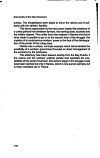
Documents of the May Movement
bureau. The shopkeepers were asked to honor the rations out of soli- I
darity with the strikers' families. I
darity with the strikers' families. I
This direct organization by the new power implied the existence of I
a united political front between farmers, the working class, students and *
the middle classes. This united front was realized in Nantes and that is i
the middle classes. This united front was realized in Nantes and that is i
what made it possible to go on to the second level of the struggle: the
creation of an autonomous workers' power in the face of the disintegra- J
creation of an autonomous workers' power in the face of the disintegra- J
tion of the power of the ruling class.
Nantes was a unique, concrete example which demonstrated the 1
possibility of a workers' government founded on direct management of
the economy by the producers.
the economy by the producers.
This testimony has drawn lessons directly from the May Events: if
the unions and the workers' political parties had exploited the pos-
sibilities of the social movement, this second stage in the struggle could
have been reached not only in Nantes, which is now just an example, but
in every industrial city in France.
the unions and the workers' political parties had exploited the pos-
sibilities of the social movement, this second stage in the struggle could
have been reached not only in Nantes, which is now just an example, but
in every industrial city in France.
184
Category
Title
When Poetry Ruled the Streets: The University as a Red Base (pages 12-13 of Cahiers de mai no.1); Nantes (pages 4-7 of Cahiers de mai no.1); From Roadblocks to Self-Defense (pages 8-11 of Cahiers de mai no.1)
Date
Unknown
Translation of
